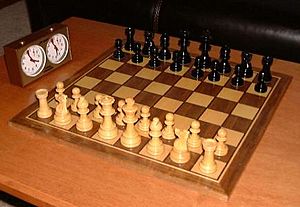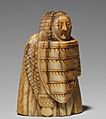Chess piece facts for kids
In the board game chess, each player starts with 16 chess pieces. The way these pieces move is set by tradition and by the international chess organization, FIDE.
Each player has:
The square at the bottom-right of the board for each player must be white.
Contents
Meet the Chess Pieces
Quick facts for kids Chess pieces |
||
|---|---|---|
| King | ||
| Queen | ||
| Rook | ||
| Bishop | ||
| Knight | ||
| Pawn | ||

The Pawn
A pawn can only move forward. It tries to reach the other end of the board. At the start of a game, pawns are placed on the second row, right in front of all other pieces. Each player begins with eight pawns.
Most of the time, a pawn moves only one square forward. But if a pawn has not moved yet in the game, it can move two squares forward, or just one.
Pawns cannot capture an enemy piece that is directly in front of them. Pawns capture in a special way. They can capture an enemy piece that is on the diagonal square to their left or right, one square forward. This is the only time a pawn moves to a square that is not straight ahead.
If a pawn reaches the very end of the board, it gets a promotion! It is removed and replaced by any other piece the player chooses, except a king or another pawn.
There's a special move called "en passant" (French for "in passing"). If an enemy pawn moves two squares on its first move, your pawn can capture it as if it had only moved one square. This can only happen on your very next move. A pawn is worth 1 point.
The Bishop
A bishop can move any number of squares diagonally. Imagine the bishop is in the middle of a big 'X'. It can move along any of the lines of that 'X'. Because of this, a bishop will always stay on squares of the same color throughout the game.
At the start, bishops are placed on the third square from the left and the third square from the right, in the row closest to each player. A bishop is worth 3 points.
The Knight
The knight is unique because it's the only piece that can jump over other pieces. When a knight moves, it first goes two squares in one direction (like a rook would move). Then, it finishes its move by going one square to the side. This move looks like the letter L.
The knight "jumps over" any pieces in its path and does not capture them. However, if a knight lands on an enemy piece, it captures it. Knights are placed on the second and seventh squares in the row closest to each player, between the rooks and the bishops. A knight is worth 3 points.
The Rook
A rook can move any number of squares: left or right along the ranks, and up or down along the files.
Rooks start on the far left and far right squares in the row closest to each player, next to the knights. A rook is worth 5 points.
The Queen
The queen is the most powerful piece! It combines the moves of both a bishop and a rook. This means it can move any number of squares in any straight direction: horizontally, vertically, or diagonally.
The queen is placed next to the king on a square that matches its own color. So, the two queens face each other exactly at the start of the game. The queen is worth 9 points.
The King
The king starts next to the queen. The king can move to any of the eight squares directly around it. It's not a very active piece, but it is always in danger. If your king is captured, you lose the game! Because of this, we don't give the king a point value.
A king can make a special move called "castling". This is when the king moves two spaces towards one of its rooks, and then that rook moves to the square on the other side of the king. You can't castle if:
- There are any pieces (your own or enemy pieces) between the king and the rook you want to castle with.
- Either the king or the rook has already moved during the game.
- The king is currently under attack (in "check"), or any square the king moves through during castling is threatened by an enemy piece. The king must not castle into check.
Images for kids
-
A pawn made of quartz from the 10th–11th century, possibly from Fatimid Egypt. Chess sets from Islamic cultures often had abstract designs.
-
An elephant piece from the 11th–12th century Islamic Western Mediterranean, possibly Nasrid Granada. It looks a bit like a Bishop's miter, which might explain why the piece is now called a bishop.
-
A 12th century warder (which is like a modern rook) made from whale ivory. It came from Scandinavia and is similar to the famous Lewis chessmen.
See also
 In Spanish: Piezas de ajedrez para niños
In Spanish: Piezas de ajedrez para niños








